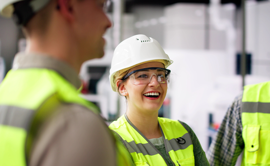Building back better: hydrogen’s place in our new normal
Published: 3 June 2020
Lockdown. It has come with more than its fair share of challenges. But it has come with benefits too. Fish have reappeared in the canals of Venice, global air quality has rapidly improved, and with diminished traffic, city dwellers have woken to the dawn chorus, rather than the gathering clamour of the morning commute.
Polls the world over reveal that the public simply don’t want to return to ‘the way things were’. We’re ready to make sacrifices for a cleaner, quieter world, and it’s a sentiment reflected in the recovery plans of many countries. At home, the UK Government promises to ‘Build Back Better’, embedding bold environmental choices into economic recovery. Now is the time for UK Hydrogen projects to take centre stage, offering us a sustainable energy source in tune with our hopes for a better, greener, ‘new normal’.
Why hydrogen?
Because hydrogen can be combusted in a way that produces no greenhouse gas emissions, hydrogen is critical for delivering net zero, with all major research expecting it to have a significant role. Alongside carbon capture and the development of hydrogen-ready domestic appliances, hydrogen can be used in the UK’s existing gas network, making it a cost-effective choice, too.
What is happening now?
Major hydrogen projects are well under way across the UK, with gas networks collaborating on the build and operation of new hydrogen and repurposed networks under the ‘Gas Goes Green’ programme. Together, these key projects will not only interconnect to help deliver a UK net zero future, but assure our nation’s place as a world leader in large-scale decarbonisation strategies.
Hynet
In the North West of England, Cadent’s HyNet is a hydrogen energy and Carbon Capture, Usage and Storage (CCUS) project. The goal of HyNet is to reduce carbon emissions from industry, homes and transport whilst supporting economic growth in the region. Working closely with Cadent’s Hydeploy project, Hynet’s aims are to trial and establish the viability of 100% H2 for industry, and a 20% blend for domestic appliances. Establishing at least one low-carbon cluster by 2030, and the world’s first net-zero carbon industrial cluster by 2040, is key to the UK Government’s Industrial Strategy. HyNet is striving to meet these goals and create a low-carbon exemplar cluster which can act as a UK model for clean growth. Read more here.
Hydeploy
Based at Keele University, Staffordshire, Hydeploy is the first ever live demonstration of hydrogen in homes. Cadent’s project aims to prove that blending up to 20% volume of hydrogen with natural gas is a safe and greener alternative to the gas we use now. The first part of this crucial three-stage project is gathering evidence that end-user appliances do not need to be replaced to use a hydrogen blend, and that domestic customers report no difference in the experience of using it. Once the Keele stage has been completed, HyDeploy will move to a larger demonstration on a public network in the North East in December 2020, before another large demonstration in the North West. These will test the blend across a range of networks and customers so that the evidence is representative of the UK as a whole. Read more here.
H21
H21 is a suite of pioneering gas industry projects led by Northern Gas Networks, demonstrating how the existing UK gas grid can be repurposed to carry 100% hydrogen, so that the UK can meet 2050 objectives. H21 has already proved conversion of the existing gas grid to carry hydrogen is technically possible and economically viable, through the 2016 H21 Leeds City Gate report.
Building on the LCG report, the North of England report looked at the conversion across the North. Undertaken by Northern Gas Networks in partnership with Equinor and Cadent, this report will establish a clear pathway for decarbonising heat, setting out the design requirements of the infrastructure needed to convert the North of England to hydrogen.
H21 is now focused on delivering two key projects, enabling policy decisions on hydrogen to be made. First up is H21 NIC phase 1, which is looking at the background evidence for assets and the consequence testing to update the QRA. Phase 2 NIC will present the evidence that a future hydrogen gas network can be managed and operated to the same safety standard as our natural gas network of today.
H100
SGN’s H100 project aims to construct and demonstrate the UK’s first new, all polyethylene, network to carry 100% hydrogen produced by an electrolysis plant, and powered by offshore wind turbine. Subject to Ofgem approval, SGN plan to build this world-first hydrogen network in Levenmouth, Fife. The project would be the first of its kind to employ a direct supply of clean power to produce hydrogen for domestic heating. The initiative also comprises a series of smaller projects that focus on each key aspect of hydrogen research.
Hy4Heat
In contrast to other projects, the particular focus of the Hy4Heat programme is ‘upstream of the meter’. It looks at the end-user context – examining the safety issues associated with using hydrogen in buildings, and the need to develop new domestic appliances that burn hydrogen rather than methane. The Department for Business, Energy & Industrial Strategy appointed Arup+ in 2018 to be the programme manager for Hy4Heat. This three-year feasibility study aims to establish if it is technically possible and safe to replace methane with hydrogen in commercial and residential buildings and gas appliances.
HyNTS
Alongside these projects, National Grid’s focus is the safe transport of hydrogen around the transmission network as part of the Hydrogen National Transmission System (HyNTS) programme. At Project Cavendish in Kent, the HyNTS programme is exploring ways to produce, store or import hydrogen in order to supply the South of London. In tandem, other projects examine the minutiae of the carriage of either 100% hydrogen or a hydrogen blend around the gas transmission network. One area of scrutiny is hydrogen deblending, which may support staged conversion to hydrogen. This has the potential to supply a hydrogen methane blend through the network, before deblending the hydrogen to supply areas ready for hydrogen, while maintaining supply of appropriate mixes to other areas.
While the future of hydrogen in our energy mix looks certain, this greener future is still a little way off. But what we can be assured of is the collaborative spirit of the UK’s major gas distributers, united in one common aim, to make the UK a world leader in decarbonisation strategies.
More from resources...
Here to achieve, validate and demonstrate compliance
Our expert consultants are available to ensure compliant and effective processes for asset design, build, maintenance, and operation.
Contact our experts





